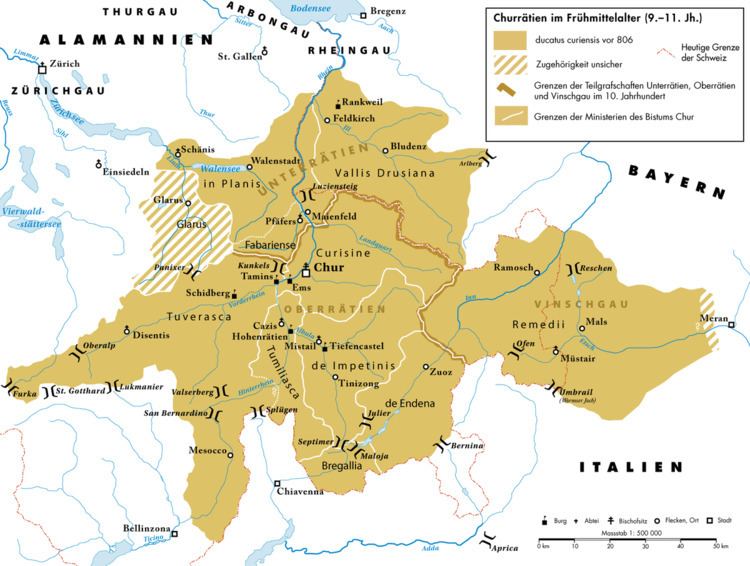Raetia prima established c. 300 Preceded by Succeeded by | Government Not specified Division 11th century | |
 | ||
Raetia Curiensis (in Latin; German: Churrätien, Romansh: Currezia) was an Early medieval province in Central Europe named after the Roman province of Raetia. Its administrative capital was Chur (Curia Raetorum.
Contents
Location
The territory of the province corresponded to modern Grisons (without Puschlav), plus Liechtenstein, parts of Vorarlberg, the Alpine Rhine Valley and Sarganserland, and until the 12th century also Vinschgau, Urseren and possibly either parts or all of Glarus.
History
The Roman province of Raetia was divided into Raetia prima and Raetia secunda under Diocletian in ca. 300 AD. The bishopric of Chur was established by 452. Nominally under Ostrogothic rule from 476, it appears that the bishops of Chur remained de facto independent rulers of Raetia prima. Theodoric appointed a dux for Raetia prima, who however had only military competences; civil administration lay with a praeses. Churraetia passed under nominal Frankish rule by 548. There are only very limited historical sources for the Merovingian period, but it seems likely that the bishops of Chur remained in charge as de facto rulers of what was now a province on the outer margins of the Frankish empire, until the 740s separated from Francia proper by the likewise de facto independent duchy of Alemannia.
In the mid-8th century a surviving Lex Romana Curiensis, a "Roman Law of Chur", was an abbreviated epitome of the Breviary of Alaric. Charlemagne from the 770s appointed the bishops of Chur himself, increasing Frankish control over the territory. In 806 or 807, he legislated a division between episcopal and comital property, ending the de facto secular rule of the bishops of Chur, appointing Hunfried I as comes curiensis (or Reciarum comes). The province was absorbed into the duchy of Swabia at the beginning of the 10th century, when Burchard II, Duke of Swabia held the title of count of Churraetia in 917 as he proclaimed the Duchy of Swabia. For this reason, Churraetia became nominally part of Swabia and by extension of the Holy Roman Empire even though it had not historically been part of Alemannia. With this as a power base, the Hunfriding heirs were able to gather enough power that Burchard II (919-926) was able to make himself duke of Swabia, and Raetia herceforward lost its separate identity. Chur suffered several invasions in the 10th century, by the Magyars in 925/6, and by the Saracens in 940 and 954. In parallel with the development of feudalism in Western Europe, political power became fragmented over the 10th and 11th centuries, and Churraetia was divided into the three counties of Oberrätien, Unterrätien and Vinschgau.
In the 12th century, these fell to the counts of Buchhorn, Bregenz and Tyrol, respectively. In the later medieval period, the bishops of Chur regained a certain amount of secular influence, which was however more limited in extent, restricted to the Chur itself, the Domleschg, Engadin, Bergell, Chiavenna, Bormio and Vinschgau.
At the end of the medieval period, political power passed to the Three Leagues which eventually became the Canton of Raetia in the Helvetic Republic and finally the modern canton of Graubünden.
Germanic–Latin boundary
In contrast to the remaining part of the former province of Raetia, Churraetia managed to retain its Latin character, giving rise to the Rumantsch language, spoken throughout its territory during the Middle Ages. Raetia prima was occasionally known as Raetia Curiensis even from the 4th century, and the German name Churrätien is simply an adaptation of the Latin name. Historically, it was also known as Churwalchen, Churwahlen in German (walha "Latin/Romance", c.f. Walenstadt). The existence of a medieval German/Latin language boundary at Walensee and the Churfirsten can still be perceived from the prevalence of Latin toponymy.
